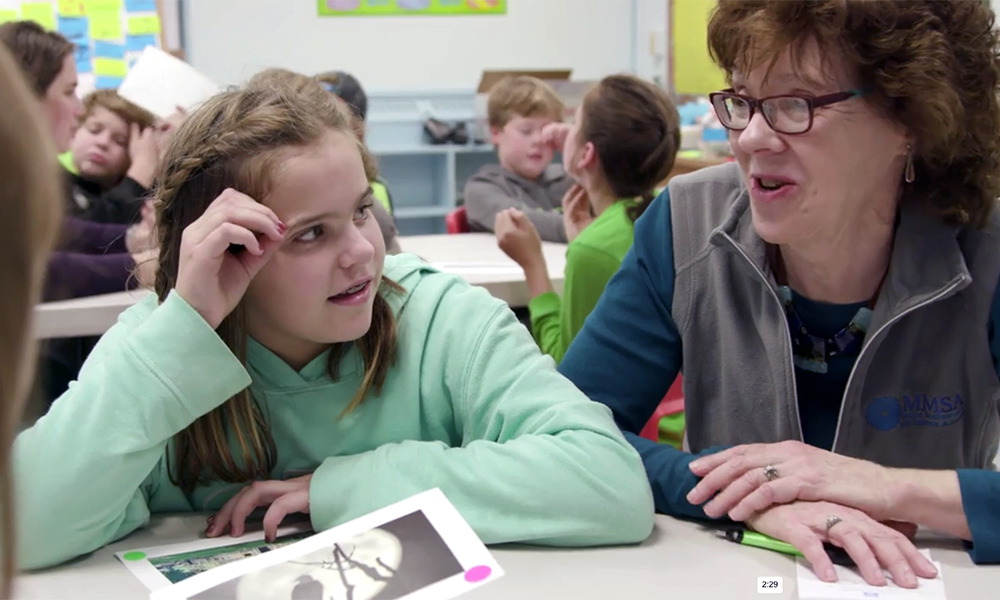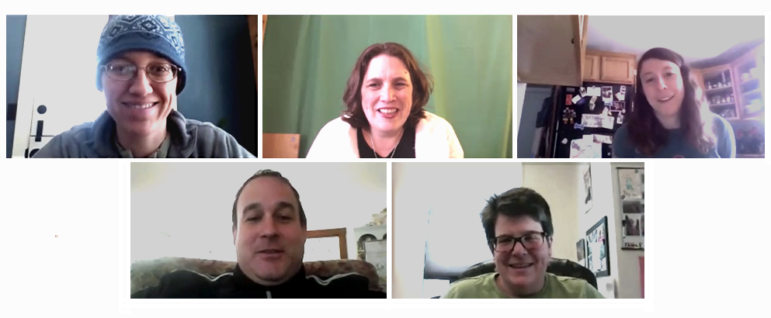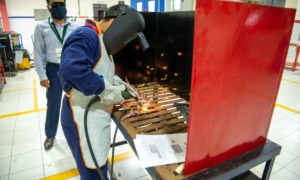
Maine Mathematics and Science Alliance
Educator Joyce Tugel practices asking a young learner purposeful questions, a skill taught in the course Afterschool Coaching for Reflective Education in STEM.
After-school programs are increasingly expected to teach science, technology, engineering and math, but staff often have little training. How do after-school staff boost their skills in teaching STEM?
Enter a program developed by the Maine Mathematics and Science Alliance. The organization’s online workshop is more than a “passive webinar,” said Sue Allen, senior research scientist of the alliance.
Allen calls it “radically interactive.” The course, Afterschool Coaching for Reflective Educators in STEM, known as ACRES, can be taught in person, online or in a blended form. The online version is an effort to reach a wider geographic area, particularly rural areas around the nation.
ACRES teaches after-school staff how to ask students purposeful questions, encourage youth inquiry and lead students in carrying out an investigation or an engineering design process.
After-school teachers literally do hands-on activities in the online workshop. They also look at and discuss videos of each others’ interaction with students.
“They have to be practicing and reflecting on their practice,” Allen said. Research has shown that practice and reflection is the most effective way of learning, she said.
In the first ACRES module, after-school staff learn to ask students purposeful questions, rather than simply showing and telling students. Skillful questioning leads students into their own inquiry.
“Getting [students] to articulate ideas is absolutely central to learning science,” Allen said. “We want to teach that model.”
Teaching teachers the right questions
When after-school staff lead STEM activities, “they generally don’t ask youth any questions at all,” Allen said. Or they might ask questions that are vague, too simple or can be answered by “yes” or “no.”
But the course teaches teachers how to question. For example, in a lesson about density, the teacher may have students place a piece of wood and a piece of metal in water to see which floats.
“What is it about this piece of wood that makes it float while the same size piece of metal sinks to the bottom?” the teacher could ask.
“It’s heavier,” students might say. The teacher could then have the students weigh the objects.
They see that the piece of wood turns out to be the heavier object.
“Why do you think it was the lighter object that sank?” the teacher might ask. setting off a chain of ideas and questions.

After-school educators can coach and be coached — and do hands-on activities online — through a STEM workshop offered by the Maine Mathematics and Science Alliance.
Innovative use of technology
To give after-school teachers practice in this type of instruction, the course uses simple technology in an innovative way, Allen said.
Participants are asked to bring objects for hands-on activities. The videoconferencing program Zoom allows the online workshop teacher to put two online participants together apart from the group. The participants can then do the activity in pairs, laughing and talking with each other on-screen.
The ability to pair participants is helpful because it’s very important for learners to feel comfortable, Allen said, which is harder to achieve in an online class since participants “don’t get to rub shoulders or have lunch together.”
Building group cohesion is important and “you have to get the culture of trust and safety,” she said.
After all, participants are looking at each other’s videos, potentially exposing themselves to criticism in a workshop that lets everyone examine their practices.
Participants are also taught how to use their cellphones to video themselves leading an activity with students. They bring the video to the group and discuss it.
“That’s where the real learning comes.” Allen said.
The Alliance has also broken new ground in its method of evaluating course effectiveness, according to Allen.
Participants take a pre- and post-assessment using multiple-choice questions. But the assessment also presents videos that can be stopped at various points and annotated. Course participants can note where they would stop and pose questions and they can analyze the video, showing what they have learned.





























